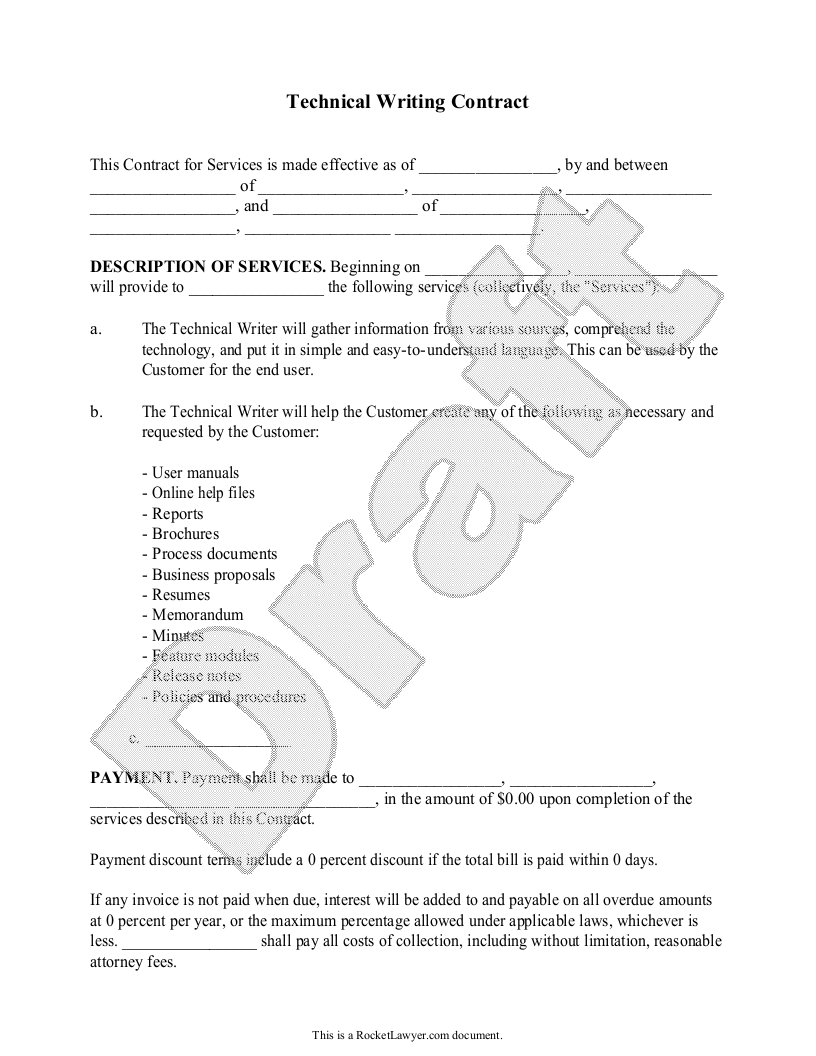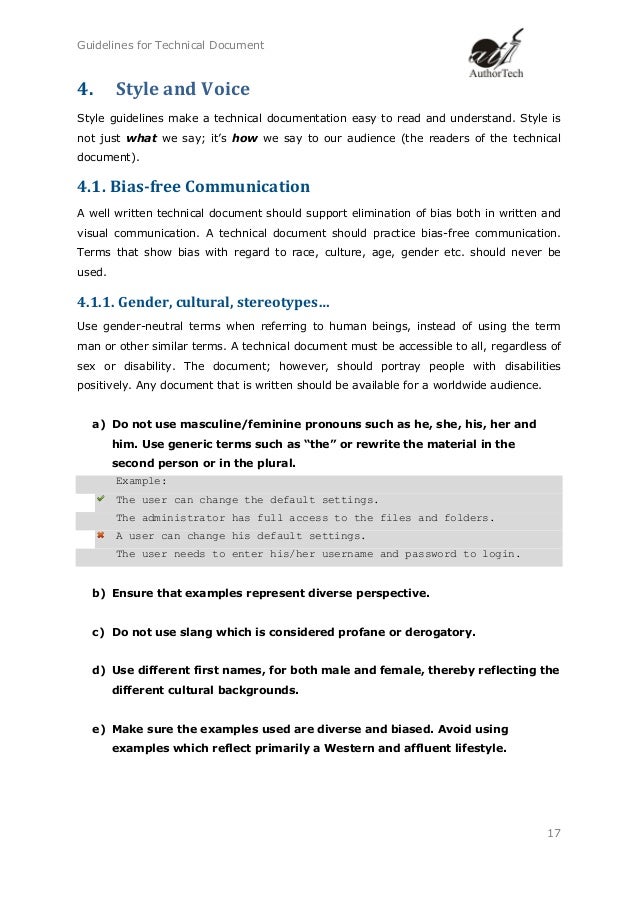
· Introduction 1. Dry sucks This is probably the hardest rule to formalize and the most important rule to follow. In the modern world 2. Before you start, be clear about what you want your reader to do after you end Technical writing is all about the 3. Write to a well formed outline, alwaysAuthor: Bob Reselman Technical writing, just as any other form of writing, has certain characteristics which distinguish it from other types of writing. It is very different from writing opinion pieces, essays, prose, non-fiction, or fiction. Technical documents are written in a business writing style rather than one that is academic or creative in nature · Documentation is the product of technical writing that refers to different documents with product-related data and information; it has the details about a technical product that is either under Author: Kesi Parker
Maintenance page
Last Updated: October 8, References Approved. To create this article, 11 people, some anonymous, worked to edit and improve it over time. There are 12 references cited in this article, which can be found at the bottom of the page. wikiHow marks an article as reader-approved once it receives enough positive feedback. This article has been viewed 88, times. Learn more Technical writing is one of the fastest growing professions and the demand for technical writers shows no signs of slowing down.
Mastering technical writing will take years of experience, practice, and constantly pushing your skills to stay up to date with the demands of the industry. Log in Social login does not work in incognito and private browsers. Please log in with your username or email to continue. wikiHow Account.
No account yet? Create an account. Community Dashboard Write an Article Request a New Article More Ideas Edit this Article. Courses New Tech Help New Expert Videos About wikiHow Pro Upgrade Sign In. Home Random Browse Articles Courses New About wikiHow Easy Technical document writing to Help Approve Questions Fix Spelling Quiz App More Technical document writing to Try We use cookies to make wikiHow great.
By using our site, you agree to our cookie policy. Cookie Settings. wikiHow is where trusted research and expert knowledge come together. Learn why people trust wikiHow, technical document writing. Categories Education and Communications Writing Non Fiction Technical Writing How to Master Technical Writing. Download Article Explore this Article parts, technical document writing. Related Articles, technical document writing. Author Info Last Updated: October 8, References Approved.
Part 1 of Be technical document writing of the skills required to be a technical writer. Unlike creative writing or opinion based writing, technical writing should help a reader understand a process, product, or subject in a clear and concise way.
Technical writing is not written to entertain or distract technical document writing reader. Instead, it should be informative and clear. Technical writers, also called technical communicators, will prepare documents like instruction manuals, journal articles, and design documents that contain information for customers, consumers, designers, and manufacturers.
You should also have a good eye for detail and be able to communicate in a clear and concise way. Most technical writers are good teachers, and can explain rules or guidelines in an educational way.
You should also have extensive knowledge of punctuation, syntax, and style, technical document writing, and have a strong grasp on sentence structure and grammar. Remember the key elements to being an effective technical writer. Strong technical writers will plan their documents technical document writing writing them and state the information with clarity, technical document writing, brevity, and simplicity.
They will also use the appropriate word choice, use the active voice as much as possible, and understand that technical writing is a process that may require editing or revising. Planning your written documents is one of the key steps to producing strong technical writing for a client.
You should keep in mind the following elements during the planning stage: [3] X Research source Identify your audience and their expectations. Understand the purpose of the document. Organize your supporting materials and outline the document. Budget the necessary time to write, revise, and edit the document. Understand the growing demand for technical writers. Technical writing is a growing field, especially in the United States.
The Bureau of Labor Statistics predict technical writing jobs will grow 15 percent faster than average for all occupations. In fact, technical writing is one of the most in demand skills by employers, especially as the technology sector continues to grow.
Having the ability technical document writing communicate effectively and teach readers about a variety of subjects will make you a very desirable candidate in the job market. Most technical writers have a college degree in technical writing or a related field, as well as some experience technical document writing a technical subject like computer science, web design, or engineering.
Many universities also offer certificate programs in technical writing. Part 2 of Focus on rhetorical awareness and user-centered design in your documents. Beyond simply writing documents that explain a process or product, strong technical writers will also be skilled at rhetoric, technical document writing.
This means you can write persuasively and eloquently about the process or product. Rather than reproduce templates or guidelines, you should consider the goals and situations around the document. This will allow you to communicate more effectively with the target audience and explain the process or product in a more user friendly way.
No matter what type of technical document you are creating, you should always consider your intended audience and make the document user-centered. Doing this will make your document accessible and understandable to your reader. Ask yourself: what information are my readers expecting to get from this document?
What information do I need to provide to readers? Think about the characteristics of the audience, technical document writing. Consider who is reading the document. Is your audience part of the decision making process in terms of the style and organization of the documents, such as stakeholders and management? Is the audience the general public or the average reader? How do the characteristics of the audience affect the document expectations? Writing a document for an audience who is familiar with the information will create a different tone than writing a document for an audience who are non specialist or general users, technical document writing.
You should also consider the reading level of your audience. Your client may specify the reading level and you should write to that reading level. Consider the goals of the audience. What is your reader planning to accomplish? What should your reader learn from the document? You should ensure the document includes all the necessary information to allow your reader to achieve their goal or goals. Try a task based approach to organize the information.
Organization is a key element of being a strong technical writer and one of the simplest ways to organize raw information or data is to break it down into a number of tasks, followed by instructions for each task. A task is a semi-independent group of actions within a procedure. For example, technical document writing the clock on an oven is one task in the procedure of operating an oven. Some procedures do not contain more than one task, for example, changing a light bulb.
But more complex procedures, like operating an oven or finding a light bulb for a certain light fixture contain several tasks. To organize a long list of tasks, group similar or related tasks together into steps. Then, group these steps into phases or stages. Number each technical document writing in a phase or a stage. For example, for operating an oven, you may have one phase titled setting up the oven, with steps on plugging the oven into a power source, setting the clock, confirming the temperature settings, and checking that the fan and oven light work properly once the oven is plugged in, technical document writing.
You can also organize the information by tools, technical document writing, rather than by tasks. Consider the tools available to the user of the product, for example, technical document writing, the user of an oven, technical document writing.
In a tools approach, you may create a section for the power source of the oven, the oven clock, the temperature setting, the fan, and the oven light. However, it can be difficult to use a tools approach for technical writing that does not involve a product or item.
Often, you will use a tasks approach in technical writing, especially if you are writing about a process. Use the active voice and action verbs. Strengthen your language use in a document by using the active, rather than the passive, voice. Describing a process in the active voice, with action verbstechnical document writing, will give your writing immediacy and clarity, technical document writing.
You may have a sentence that uses the passive voice, such as: "Light pressure should be applied on the oven door to ensure it is technical document writing properly.
Simplify any terms or phrases when possible. If you are using jargon or slang in technical document writing documents, you should consider if your audience will understand this jargon. If the jargon is unfamiliar to them, you must define these unfamiliar terms, or replace these terms with simplified language. A good rule of thumb is to never use two words when one word will do.
Focus on paring down your language so the essential meaning is clear to your reader and the meaning is not cluttered by unnecessary information or terms. Often, technical terms will be abbreviated in documents. You should always spell out the abbreviations when they are first mentioned in a section and then use the abbreviation in the rest of the section to avoid redundancy.
Integrate graphics and visual aids.
Writing technical documentation
, time: 18:045 Steps to Create Technical Documentation That’s (Actually) Helpful | Planio

· Introduction 1. Dry sucks This is probably the hardest rule to formalize and the most important rule to follow. In the modern world 2. Before you start, be clear about what you want your reader to do after you end Technical writing is all about the 3. Write to a well formed outline, alwaysAuthor: Bob Reselman · Documentation is the product of technical writing that refers to different documents with product-related data and information; it has the details about a technical product that is either under Author: Kesi Parker Technical writing, just as any other form of writing, has certain characteristics which distinguish it from other types of writing. It is very different from writing opinion pieces, essays, prose, non-fiction, or fiction. Technical documents are written in a business writing style rather than one that is academic or creative in nature
No comments:
Post a Comment